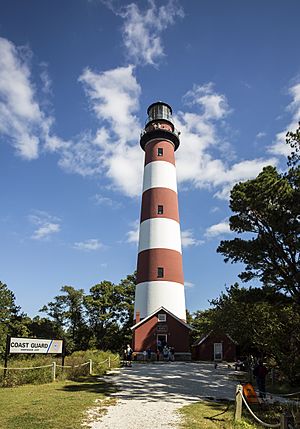Assateague Light facts for kids
 |
|
| Assateague Lighthouse, September 2017 | |
|
|
|
| Location | south of Chincoteague, Virginia |
|---|---|
| Coordinates | 37°54′40″N 75°21′22″W / 37.91118°N 75.356°W |
| Year first lit | 1867 |
| Automated | 1933 |
| Deactivated | N/A |
| Foundation | Stone & Concrete |
| Construction | Red Brick |
| Tower shape | Conical |
| Height | 142 feet (43 m) |
| Original lens | first-order Fresnel Len |
| Range | 19 miles (17 nmi; 31 km) |
| Characteristic | Double-flash every five seconds |
The Assateague Light is a 142-foot-tall (43 m) lighthouse located on the southern end of Assateague Island off the coast of the Virginia Eastern Shore, United States. It helps ships navigate safely.
This lighthouse is found within the Chincoteague National Wildlife Refuge. You can get to it by road from Chincoteague Island by crossing the Assateague Channel. The U.S. Fish and Wildlife Service owns the lighthouse. The U.S. Coast Guard operates it, and it is still an active aid for navigation. The old keeper's quarters are used as housing for refuge employees, volunteers, and interns during certain seasons.
The current lighthouse was built in 1867. It replaced an older, shorter lighthouse that was only 45-foot-tall (14 m) and built in 1833. The Assateague Light is shaped like a cone and has alternating bands of red and white paint.
A big renovation project was finished in October 2013. This work cost $1.5 million. It included replacing the lower deck, changing glass, fixing the top viewing area (called a widow's walk), and painting the outside.
History of the Assateague Light
Long ago, there was no lighthouse between Cape Henlopen, Delaware, and Cape Charles, Virginia. This made sailing dangerous at night. In 1830, the United States Congress decided to set aside money for a light near Chincoteague Island. The next year, the Collector of Customs in Norfolk chose Assateague Island as the spot.
The first Assateague Lighthouse was built on the southern tip of the island. Barrier islands like Assateague Island are always changing. The island has grown about 5 miles (8 kilometers) since the lighthouse was first built. Over the years, a hook-shaped piece of land has formed to the south. The area inside this hook has slowly filled with sand.
The lighthouse originally had a special Fresnel lens to make its light bright. This lens has since been replaced with a more powerful beacon that uses electricity. The original Fresnel lens from the lighthouse is now on display at the Museum of Chincoteague Island.
The lighthouse grounds also have a keeper's house and an oil house. These buildings were important for the lighthouse keepers who lived and worked there.
The Assateague Light was featured on the 2003–2004 Federal Duck Stamp. This stamp was designed by an artist named Ron Louque.
You can visit the lighthouse! It is open for public tours on weekends during the summer months.
Gallery
-
Assateague Channel with Assateague Light in distance
Images for kids








